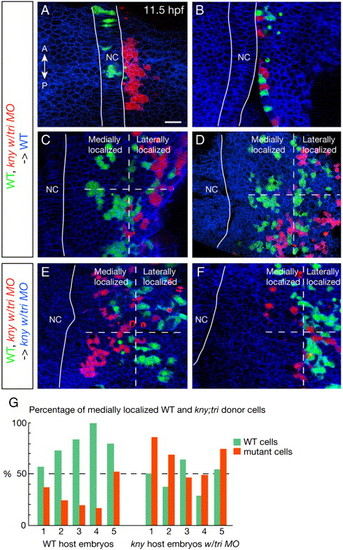Fig. 6
- ID
- ZDB-FIG-070905-12
- Publication
- Yin et al., 2007 - Convergence and extension movements mediate the specification and fate maintenance of zebrafish slow muscle precursors
- Other Figures
- All Figure Page
- Back to All Figure Page
|
Cell autonomy of Kny and Tri in adaxial cell specification and convergence movements of the PSM. Cells from WT (green) and tri MO-injected kny mutant embryos (red) were co-transplanted into the WT (A–D) or kny;tri-deficient (E–F) host embryos (Materials and methods). (A–F) Confocal images of the host embryos stained with β-catenin antibody at 11.5 hpf. (A–B) When located next to the notochord in the WT hosts, the kny;tri-deficient donor cells formed adaxial cells that exhibited the characteristic epithelial-like morphology. (C–D) In the WT hosts, the WT donor cells were located more medially than the kny;tri-deficient donor cells. (E–F) In the kny;tri-deficient hosts, the WT donor cells were intermingled with the mutant donor cells. In (C–F), the horizontal dashed lines show the ML range of the transplanted donor cell population. The vertical dashed lines separate the donor cell population into the medial and lateral halves. (A–F) Dorsal views. NC, notochord. Scale bar: 20 μm. (G) Quantification of the proportions of WT and kny;tri-deficient donor cells that are located in the medial half of the transplanted donor cell population. Data from 5 WT and 5 kny;tri deficient host embryos are shown. Each host embryo contains on average of 43 WT donor cells and 38 mutant donor cells. |
Reprinted from Developmental Biology, 304(1), Yin, C., and Solnica-Krezel, L., Convergence and extension movements mediate the specification and fate maintenance of zebrafish slow muscle precursors, 141-155, Copyright (2007) with permission from Elsevier. Full text @ Dev. Biol.

